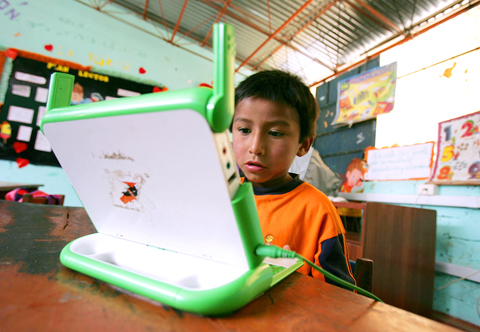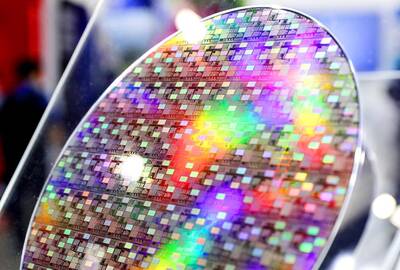The One Laptop Per Child (OLPC) project is about to find out whether Microsoft Corp, a rival the nonprofit group once derided, is the solution to its problems in spreading inexpensive portable computers to schoolchildren.
Microsoft and the laptop organization announced on Thursday that the nonprofit’s green-and-white “XO” computers now can run Windows in addition to their homegrown interface, which is built on the open Linux operating system. That had been anticipated for months, but it amounts to a major shift.
Nicholas Negroponte, the founder of OLPC — which aims to produce US$100 computers but now sells them at US$188 — acknowledged that having Windows as an option could reassure education ministers who have hesitated to buy XOs with its new interface, called Sugar. Negroponte had hoped to sell several million laptops by now; instead he has gotten about 600,000 orders.

PHOTO: AP
Beginning in limited runs next month, XO buyers will have the option of computers loaded with or without Windows. Versions with Windows will cost US$18 to US$20 more; US$3 of that is for Windows, and the rest covers hardware adjustments, like an additional memory-card slot, needed to make Windows run.
Soon Negroponte hopes to sell just one kind of machine with a “dual-boot” mode, meaning users would have Windows and Linux and choose which to run each time. Because that will take advantage of a broader hardware redesign, the dual-boot XOs will cost about US$10 more than today’s versions, Negroponte said.
Despite the higher price — and Windows’ inability to take advantage of some key features of the XO — Negroponte said his project would benefit from Microsoft’s strengths in selling and deploying technology.
“I think our goals are dramatically enhanced with Microsoft’s decision and this partnership because we will reach many more children,” he said.
“There are now many more countries prepared to look at the XO and collaborative learning and some of the things we stand for,” he said.
The partnership culminates an odd dance.
Not long after Negroponte first dreamed up the idea of seeding the developing world with US$100 laptops for education, he talked with Microsoft about using a version of Windows on the machines. That seemed to vanish before long, as Microsoft’s Bill Gates and a close partner, Intel Corp chairman Craig Barrett, publicly dismissed the XOs’ scaled-back processing power and small screen.
At first Negroponte wore the criticism as a badge of honor, saying it showed that his little group would upend the laptop market.
“When you have both Intel and Microsoft on your case, you know you’re doing something right,” Negroponte said to cheers at a Linux convention in 2006.
Negroponte had other reasons for pursuing a path separate from Windows. For one, Linux is free. That’s key when you’re trying to make a computer for US$100 Plus, Linux was seen as easier to configure for the XOs’ specific innovations, such as its ultra-low power consumption.
Negroponte and his crew also talked about how the open nature of Linux better suited the project’s vision for “constructivist” learning, with children teaching each other and themselves by tinkering with the computer. Negroponte has said he finds it sad when children learn to use computers mainly as tools for office automation.
“The hundred-dollar laptop is an education project,” he often said. “It’s not a laptop project.”
However, it’s enough of a laptop project that Negroponte is eager to speed XO sales and donations beyond their initial deployments, which include Haiti, Afghanistan, Rwanda, Mexico, Peru, Uruguay, Mongolia and Birmingham, Alabama.
Negroponte’s first big change was to make peace with Intel last year, in hopes of boosting XOs’ technical development and blunting competition from Intel’s Classmate PCs. But the relationship ended after only a few months.
The Microsoft relationship looks sturdier. Microsoft engineers spent the past year customizing a version of Windows that can run on XOs. Even so, XOs running Windows for now can’t use some of the machines’ security features and their built-in “mesh” wireless networking.
Negroponte indicated last month that eventually, Windows could be the sole operating system, with Sugar serving as educational software running on top of it. But he said Thursday he does not envision that happening.
Still, a key question will be whether having Windows on the laptops means children make less use of Sugar, one of the project’s core innovations.

WAITING GAME: The US has so far only offered a ‘best rate tariff,’ which officials assume is about 15 percent, the same as Japan, a person familiar with the matter said Taiwan and the US have completed “technical consultations” regarding tariffs and a finalized rate is expected to be released soon, Executive Yuan spokeswoman Michelle Lee (李慧芝) told a news conference yesterday, as a 90-day pause on US President Donald Trump’s “reciprocal” tariffs is set to expire today. The two countries have reached a “certain degree of consensus” on issues such as tariffs, nontariff trade barriers, trade facilitation, supply chain resilience and economic security, Lee said. They also discussed opportunities for cooperation, investment and procurement, she said. A joint statement is still being negotiated and would be released once the US government has made

NEW GEAR: On top of the new Tien Kung IV air defense missiles, the military is expected to place orders for a new combat vehicle next year for delivery in 2028 Mass production of Tien Kung IV (Sky Bow IV) missiles is expected to start next year, with plans to order 122 pods, the Ministry of National Defense’s (MND) latest list of regulated military material showed. The document said that the armed forces would obtain 46 pods of the air defense missiles next year and 76 pods the year after that. The Tien Kung IV is designed to intercept cruise missiles and ballistic missiles to an altitude of 70km, compared with the 60km maximum altitude achieved by the Missile Segment Enhancement variant of PAC-3 systems. A defense source said yesterday that the number of

‘CRUDE’: The potential countermeasure is in response to South Africa renaming Taiwan’s representative offices and the insistence that it move out of Pretoria Taiwan is considering banning exports of semiconductors to South Africa after the latter unilaterally downgraded and changed the names of Taiwan’s two representative offices, the Ministry of Foreign Affairs (MOFA) said yesterday. On Monday last week, the South African Department of International Relations and Cooperation unilaterally released a statement saying that, as of April 1, the Taipei Liaison Offices in Pretoria and Cape Town had been renamed the “Taipei Commercial Office in Johannesburg” and the “Taipei Commercial Office in Cape Town.” Citing UN General Assembly Resolution 2758, it said that South Africa “recognizes the People’s Republic of China (PRC) as the sole

Taiwanese exports to the US are to be subject to a 20 percent tariff starting on Thursday next week, according to an executive order signed by US President Donald Trump yesterday. The 20 percent levy was the same as the tariffs imposed on Vietnam, Sri Lanka and Bangladesh by Trump. It was higher than the tariffs imposed on Japan, South Korea and the EU (15 percent), as well as those on the Philippines (19 percent). A Taiwan official with knowledge of the matter said it is a "phased" tariff rate, and negotiations would continue. "Once negotiations conclude, Taiwan will obtain a better